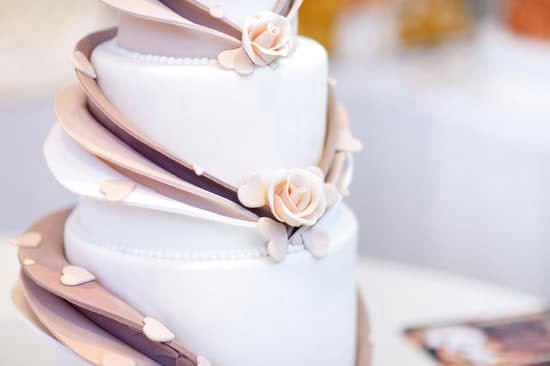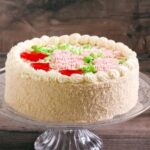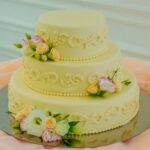Cake Border Decoration plays a vital role in enhancing the overall presentation and aesthetics of a cake. It is not just about adding an extra touch of beauty, but it also has a significant impact on the visual appeal and first impressions of any cake creation. Whether you are a professional baker or someone who enjoys baking as a hobby, mastering the art of cake border decoration is essential to elevate your cake designs to the next level.
Presentation is key when it comes to any form of culinary art, and cakes are no exception. A beautifully decorated cake with intricate borders can instantly captivate everyone’s attention and make them eager to indulge in its deliciousness. Cake borders help define the edges of the cake, giving it a polished and professional look. They act as frames, drawing focus to the main centerpiece of the cake and providing a seamless transition between different layers or tiers.
Furthermore, cake borders offer endless opportunities for creativity and personalization. With various techniques and styles available, you can create unique designs that perfectly complement different occasions and themes. From simple piped borders to elaborate fondant creations, each style has its own charm that adds a touch of elegance or playfulness to your cakes. The possibilities are truly endless, allowing you to showcase your artistic skills and impress your family, friends, or clients with stunning cakes.
In this article, we will delve into the world of cake border decoration, exploring different techniques and styles that you can experiment with. We will provide comprehensive guides on the tools and materials needed for each method so that you can gather everything required before venturing into your decorating adventure. Additionally, we will share step-by-step instructions, tips from experts in the field, troubleshooting advice for common issues, and even showcase inspirational examples from renowned bakers.
Whether you are an amateur baker looking to improve your skills or a seasoned professional searching for fresh ideas, this article will serve as your go-to resource for all things related to cake border decoration. Get ready to elevate your cake designs to new heights and leave a lasting impression with impressive and intricate cake borders that will not only tantalize taste buds but also mesmerize eyes.
Types of Cake Border Decoration
Cake border decoration offers endless possibilities for creativity and adds the perfect finishing touch to any cake. There are various techniques and styles that can be used to create beautiful and unique borders. Here are some popular methods of cake border decoration:
- Piped Borders: Piping is a classic technique where decorative icing is squeezed through a piping bag fitted with a specific tip to create intricate designs on the cake edges. This technique allows for precise control over the thickness, shape, and pattern of the border. It is commonly used to create swirled patterns, scalloped edges, or elegant rope designs.
- Fondant Borders: Fondant is a smooth and pliable sugar paste that can be rolled out thinly and molded into various shapes to create borders. Fondant borders provide a clean and polished look to cakes and can be made in different widths, textures, and designs. They can also be embellished with edible decorations such as pearls or flowers.
- Lace Borders: Lace borders add an element of elegance and sophistication to cakes. Edible lace is created using special molds or stencils that imprint intricate lace patterns onto fondant or edible paper strips. Once dried, these delicate lace borders can be easily attached to the cake for a beautiful finishing touch.
- Brush Embroidery Borders: Brush embroidery involves using edible food coloring or paint to create delicate brush strokes on dried royal icing, buttercream, or fondant surfaces. This technique gives the illusion of embroidered fabric and adds texture and dimension to the cake borders.
Whether you prefer traditional piped borders, modern fondant creations, delicate lace patterns, or artistic brush embroidery, each method offers its own unique style for creating stunning cake borders that will impress guests and elevate your cake designs.
In addition to these methods, there are countless other creative techniques that can be used for cake border decoration such as chocolate ganache drips, edible paper cutouts, wafer paper ruffles, and more. The key is to experiment with different techniques and styles to discover your own personal favorites and to match the theme or occasion of each cake.
Tools and Materials Needed for Cake Border Decoration
Cake border decoration requires the right tools and materials to achieve beautiful and professional-looking results. Whether you prefer piping borders or working with fondant, having a comprehensive guide on the essential tools will help you create stunning cake borders.
- Piping Bags and Tips: Piping bags are a must-have tool for creating intricate and delicate designs on cake borders. They come in various sizes and can be made of disposable or reusable materials. Paired with different piping tips, such as round tips for simple borders or star tips for more intricate designs, you can easily create different patterns and textures.
- Fondant Cutters: Fondant cutters are specifically designed to cut out shapes from fondant or gum paste to decorate cake borders. They can come in a set with various sizes and shapes like flowers, hearts, leaves, and more. Using fondant cutters allows you to create consistent and precise decorations for your cake borders.
- Stencils: Stencils are a versatile tool used to transfer intricate designs onto cake borders using royal icing or edible dusts. They come in different patterns, such as lace, filigree, damask, or floral motifs. Stencils provide an easy way to add detail and visual interest to your cake borders without the need for advanced piping skills.
- Edible Decorations: Adding edible decorations like pearls, beads, dragees, edible glitter, or sugar flowers can enhance the beauty of your cake borders. These decorations can be applied using food-safe glue or by attaching them directly onto the border while it’s still wet.
- Turntable: A turntable is not only useful for frosting cakes but also for creating smooth and even cake borders. This rotating platform allows for easier control when applying buttercream or fondant to achieve clean and seamless lines.
Remember that having quality tools makes a significant difference in your decorating experience and final results. Investing in these essential tools will help you achieve professional-looking cake borders and elevate the overall presentation of your cakes.
Step-by-Step Guide to Piped Cake Borders
Piping cake borders is not only a beautiful and elegant way to finish off your cake, but it also adds a professional touch to your creation. With various designs and endless possibilities, mastering the art of piped cake borders will take your cake decorating skills to the next level.
To begin piping cake borders, you will need a few essential tools. Firstly, you will need a piping bag, which can be made of disposable plastic or reusable fabric. Next, choose the appropriate piping tip for the design you want to achieve.
There are many different tips available, such as round, star, leaf, or petal tips. It’s best to have a variety of sizes on hand for flexibility in design. Additionally, having couplers and a practice board or parchment paper is recommended for practicing and testing out different techniques.
Before you start piping your border, prepare your icing consistency. For borders, a medium stiff consistency is generally used so that the lines hold their shape and don’t spread too much. To achieve this consistency, gradually add small amounts of liquid (such as water or milk) to your icing mixture until it becomes smooth and holds its shape when piped. Be careful not to add too much liquid as this will make the icing runny.
Now it’s time to pipe. Start by filling your piping bag with the prepared icing and securely close it at the top by twisting or using a rubber band. Hold the bag comfortably in one hand with your dominant hand placed near the twist closure for control.
To create even borders, try placing guide marks on your cake using toothpicks or lightly scoring the surface with a knife where you want your border to go. This will help you maintain consistent sizing and spacing throughout.
To pipe a basic border design like dots or beads, hold the bag at approximately a 45-degree angle with the tip slightly above the cake surface. Apply even pressure and gently squeeze the bag while moving your hand in a smooth, circular motion to create uniform dots. Continue around the border until you meet the starting point.
For more intricate designs like shells, ropes, or ruffles, practice on a piece of parchment paper or a practice board first before piping directly onto your cake. This will help you perfect the technique and ensure that you’re happy with how it looks before committing it to your cake.
Remember to take your time and work at a comfortable pace. If you make a mistake or aren’t satisfied with a section of your border, simply scrape off the icing and start again. It’s all part of the learning process.
By following these step-by-step instructions and practicing different designs, you’ll soon master the art of piped cake borders. Remember to have fun and let your creativity shine through as you explore different techniques, mix and match tips for unique borders, and experiment with colors. Happy decorating.
Creating Stunning Fondant Cake Borders
Creating stunning fondant cake borders requires skill and patience, but the result is worth the effort. Fondant is a versatile and pliable material that allows for intricate and beautiful designs. In this section, we will explore the process of working with fondant to create various border styles, as well as provide tips and techniques for embellishing with edible decorations and adding color.
To start, it’s important to have a clean and smooth surface to work on. Dust your work surface with powdered sugar or cornstarch to prevent sticking. Roll out your fondant into a thin layer using a rolling pin. You can use fondant smoothers or your hands to help flatten and even out the thickness of the fondant.
Next, you can begin molding and shaping your desired border style. There are endless possibilities when it comes to fondant border designs – from simple ruffles to intricate lace patterns. To create ruffles, you can use a ball tool or a toothpick to frill the edges of the fondant strip by gently rolling back and forth along the edge. For lace patterns, you can use silicone molds or lace impression mats to imprint intricate designs onto the fondant.
Embellishing with edible decorations is another way to enhance your cake borders. You can use edible pearls, dragees, or small flower cutouts made from gum paste or modeling chocolate. Attach these decorations onto your fondant borders using edible glue or water, ensuring that they adhere securely.
Lastly, adding color to your fondant borders can make them stand out even more. Use gel food coloring or edible dusts mixed with clear alcohol or lemon extract for best results. Start with small amounts of color and gradually add more until you achieve your desired shade. Knead the color into the fondant until it is evenly distributed.
By following these tips and techniques for creating stunning fondant cake borders, you can elevate your cake designs to new heights. The intricate details and added embellishments will enhance the overall presentation of your cakes and impress your guests. So don’t be afraid to experiment and let your creativity shine through with fondant cake borders.
Unique Cake Border Ideas for Different Occasions
When it comes to cake border decoration, there are endless possibilities for creativity and personalization. Whether you’re preparing a cake for a birthday, wedding, baby shower, or holiday celebration, adding unique cake borders can take your design to the next level. In this section, we will explore some creative border designs that are suitable for different occasions, providing sample images and explanations to inspire your own creations.
For birthday cakes, consider incorporating vibrant and playful elements into your border design. One popular idea is to use piped buttercream to create colorful confetti borders. Simply fill a piping bag fitted with a small round tip with various shades of buttercream and pipe small dots around the edges of the cake. This simple yet effective technique adds a festive touch that’s perfect for birthdays of all ages.
Wedding cakes often call for elegant and sophisticated border designs. One classic option is a lace border made from fondant or edible lace. Roll out white fondant thinly and use a lace mold to imprint delicate patterns onto the surface. Carefully attach the lace strips onto the bottom edge of the cake using edible glue or water. This creates a beautiful and timeless border that complements any wedding theme.
For baby showers, consider incorporating cute and whimsical elements into your cake borders. A popular trend is to create an adorable diaper ruffle border using fondant or modeling chocolate. Roll out thin strips of colored fondant or chocolate and shape them into pleated ruffles resembling baby diapers. Attach these ruffles along the bottom edge of the cake for an adorable finishing touch that will delight guests.
Finally, holidays offer great opportunities for themed cake borders. For example, during Christmas time, you can create an intricate snowflake border using royal icing or white chocolate decorations. Pipe delicate snowflake designs onto parchment paper using royal icing or melt white chocolate into snowflake shapes using molds. Once hardened, gently attach these edible snowflakes around the edges of the cake for a festive and winter wonderland-inspired border.
By incorporating unique cake borders that are tailored to specific occasions, you can truly showcase your creativity and enhance the overall theme of your cake. Keep in mind that these are just a few examples, and the possibilities are truly endless. Don’t be afraid to experiment with different techniques, colors, and materials to create borders that are as unique as the cakes themselves.
Troubleshooting Common Cake Border Decoration Issues
Uneven Borders
One common issue that cake decorators may encounter when working on cake borders is achieving an uneven finish. Uneven borders can be caused by several factors, such as inconsistent piping pressure or an unstable surface to work on. To fix this issue, it is important to maintain a steady hand and even pressure when piping the border.
Practice control and apply consistent pressure throughout the piping process. Additionally, make sure that your cake is sitting on a sturdy and level surface, such as a turntable or cake stand, to prevent any wobbling or tilting that could result in an uneven border.
If you still struggle with achieving even borders, another solution is to use templates or guides to ensure precise lines and shapes. These templates can be made from cardboard or acetate sheets and can be placed around the cake as a guide for piping or applying fondant borders. Simply trace the desired shape onto the template and carefully follow it while decorating your cake.
Icing Consistency Issues
Having issues with icing consistency can greatly affect the outcome of your cake border decorations. If your icing is too thick, it can cause difficulties in piping smooth lines or creating intricate designs. On the other hand, if your icing is too thin, it may not hold its shape and can result in droopy or messy borders.
To fix icing consistency issues, start by adjusting the amount of liquid in your recipe. If your icing is too thick, add small amounts of liquid (such as milk or water) until you reach a more spreadable consistency. Conversely, if your icing is too thin, gradually incorporate powdered sugar into the mixture until it thickens up.
Another tip for achieving the right consistency is to test your icing before using it on your cake. Pipe a small amount onto parchment paper or a spare piece of cake to see how it holds its shape and flows. This will allow you to make any necessary adjustments before decorating your cake.
Fondant Cracking
Working with fondant can bring its own set of challenges, including the issue of fondant cracking. Fondant cracking can occur due to various reasons, such as over-kneading, inadequate moisture, or improper handling.
To prevent fondant cracking, ensure that your fondant is properly kneaded and conditioned. Over-kneading can cause the fondant to become dry and brittle, making it more prone to cracking. Take care to knead your fondant until it becomes smooth and pliable, but stop before you notice any signs of dryness or tearing.
Moisture is also key in preventing fondant from drying out and cracking. When working with fondant, make sure to keep the surface moist by lightly brushing it with water or using a thin layer of shortening. This will help the fondant stay flexible and less likely to crack.
Lastly, handle the rolled-out fondant gently when applying it to the cake. Avoid stretching or tugging on the fondant excessively as this can lead to cracks. Instead, carefully lift and lay the fondant onto the cake’s surface, smoothing it gently with your hands or a smoothing tool.
By addressing these common issues and using the appropriate techniques and solutions outlined above, you can troubleshoot any cake border decoration problems that may arise during your baking adventures. Remember that practice makes perfect, so don’t be discouraged if you encounter difficulties at first. With time and experience, you will master the art of cake border decoration and be able to create flawless designs for every occasion.
Tips for Achieving Professional-Looking Cake Borders
Attention to Detail
One of the key secrets to achieving professional-looking cake borders is paying close attention to detail. Expert bakers understand that even the smallest imperfection can detract from the overall appearance of the cake. Therefore, they take the time to meticulously plan and execute each border design.
To ensure precision, professional cake decorators often use tools like rulers, grid guides, or templates when piping or applying fondant for their borders. This allows them to create clean and straight lines, perfect symmetry, and consistent spacing between designs.
Additionally, attention to detail also involves selecting the right color palette for the cake borders. Professional bakers consider factors such as the theme, occasion, and overall aesthetics of the cake when choosing colors. They often use color theory principles to create visually appealing combinations that enhance the overall presentation of the cake.
Practicing Precision
Precision is another crucial aspect of achieving professional-looking cake borders. Expert bakers understand that consistency in size and shape is essential for a polished finished look.
To practice precision, they recommend using measured amounts of icing or fondant when piping or sculpting borders. Measuring tools like weighing scales or measuring cups ensure that each border has consistent thickness and height throughout.
Furthermore, professional cake decorators emphasize practicing different techniques repeatedly until they achieve a consistent result. This could involve practicing piping straight lines with different piping tips or perfecting smooth fondant shapes by using molds or cutters.
Practicing precision not only helps in creating visually appealing borders but also improves efficiency as decorators become more familiar with various techniques.
Experimenting with New Techniques
Expert bakers constantly push themselves to try new techniques and stay updated with current trends in cake border decoration. By experimenting with fresh ideas, they are able to develop their own unique style and differentiate their cakes from others.
One way professionals stay current with new techniques is by attending workshops, classes, or conventions where they can learn from other skilled decorators. They may also follow online tutorials or join online cake decorating communities to discover new trends and gain inspiration from fellow bakers around the world.
Moreover, expert bakers often experiment with different tools and materials to create innovative cake borders. This could include using unconventional items like cookie cutters, stencils, or even everyday objects as a pattern for their borders.
By embracing experimentation and continuously expanding their skill set, professional cake decorators are able to offer fresh and exciting designs that captivate their clients and elevate their cakes to a whole new level of artistry.
Cake Border Inspiration
Floral Elegance: A Delicate Touch
We begin our showcase of stunning cake border designs with a display of floral elegance. Renowned bakers have mastered the art of incorporating delicate flowers into their cake borders, creating a breathtakingly beautiful and romantic effect.
From hand-piped buttercream roses to fondant blossoms, these intricate floral designs can instantly transform a plain cake into a work of art. Whether you’re celebrating a wedding, anniversary, or simply want to add a touch of nature to your dessert, floral-inspired cake borders are sure to impress.
Whimsical Whirls: Adding Playfulness
For those seeking a more whimsical approach, the use of playful swirls in cake border decoration is perfect for adding charm and character to any occasion. Using piped royal icing or buttercream, expert bakers create enchanting swirls that seamlessly flow around the cake’s edges. These graceful lines can be accented with edible pearls or dragees for an extra touch of elegance. Whimsical whirls are particularly popular for birthday cakes, where they add a festive and joyful atmosphere.
Geometric Glamour: Modern and Sophisticated
If you’re looking for a more contemporary and sophisticated cake border design, then geometric patterns are the way to go. With clean lines and precise angles, these borders create an eye-catching contrast against the softness of the cake itself.
Expert decorators achieve this look by using fondant cutters or stencils to create geometric shapes such as squares, triangles, or hexagons. The versatility of this style allows it to fit seamlessly into various occasions, from modern weddings to corporate events.
Retreating Practice Session:
Now that you have explored some inspiring cake border designs from renowned bakers around the world, it’s time to embark on your own creativity journey. Grab your piping bags, fondant tools, and let your imagination run wild. Experiment with different techniques, colors, and patterns to create unique cake border decorations that reflect your personal style or suit a specific occasion.
Remember, the key to successful cake border decoration is practice. Don’t be discouraged if your first attempts are not perfect – every baker starts somewhere. Take your time, seek inspiration from others, and gradually refine your skills until you achieve the desired result. Whether you’re piping elegant roses or molding fondant shapes, each stroke of creativity brings you closer to mastering the art of cake border decoration.
So go ahead, elevate your cake designs with impressive borders that will leave a lasting impression on all who indulge in your sweet creations. With dedication and passion for the craft, you’ll soon discover the endless possibilities for creativity and inspiration that lie within this essential element of cake decoration.
Conclusion
In conclusion, cake border decoration is an essential aspect of cake design that should not be overlooked. The presentation of a cake can greatly impact the overall impression it makes, and cake borders play a key role in enhancing the visual appeal. Throughout this article, we have explored various techniques and styles for cake border decoration, discussed the necessary tools and materials, provided step-by-step guides, troubleshooting tips, and showcased inspiring ideas from expert bakers.
By experimenting with different techniques and styles of cake border decoration, you have the opportunity to elevate your cake designs to a whole new level. Piped borders offer endless possibilities for creating beautiful designs with icing, while fondant borders allow for intricate detailing and embellishments. Lace borders add a touch of elegance to any cake.
The impact that well-executed cake border decoration can have on the overall presentation of a cake is undeniable. It adds depth, texture, and visual interest to even the simplest cakes. Whether you are celebrating a birthday, wedding, baby shower or any other special occasion, incorporating impressive cake borders into your designs will help make them truly remarkable.
Frequently Asked Questions
How to decorate a cake border?
Decorating a cake border is a wonderful way to add a finishing touch and elevate the overall look of your cake. There are various ways to decorate a cake border, depending on the style and theme you wish to achieve. One common method is using buttercream frosting and a piping bag fitted with a small round tip.
Start by squeezing a small amount of frosting onto the base of the cake, then slowly apply gentle pressure while moving the piping bag in an upward motion to create swirls or rosettes. You can also experiment with different tips, such as star tips, to create unique designs. In addition to piping, you may consider using edible pearls, sprinkles, or fresh flowers to enhance the border further.
How to make a swirl border on a cake?
Creating a swirl border on a cake gives it an elegant and eye-catching appeal. To make this decorative element, start by smoothing out the sides of your cake with frosting using an offset spatula or bench scraper for a clean canvas. Prepare a piping bag fitted with a large star tip and fill it with buttercream or whipped cream frosting of your choice.
Hold the piping bag perpendicular to the surface of the cake and gently squeeze while maintaining consistent pressure as you move your hand in a circular motion around the outer edge of the cake. This will result in beautiful swirls that gradually form into peaks resembling soft serve ice cream cones.
How do you make a ruffle border on a cake?
A ruffle border adds an intricate and delicate touch to any cake design, making it suitable for special occasions like weddings or birthdays. To create this beautiful decoration, ensure that your cake is frosted smoothly and has chilled for some time so that it holds its shape better during application. Prepare buttercream frosting (dyed if desired) and fill a piping bag secured with either petal or leaf-shaped tip (generally numbered 104). Hold the narrow end of the tip flush against the side of your cake at about a 45-degree angle from vertical; pipe a generous amount of frosting while applying slight pressure.
Next, move the tip back and forth in a gentle wave-like motion to create smooth ruffles that create a frilly border around the cake. Repeat this process until you have completed the desired border length, ensuring you maintain consistency in your movements for an even result. Finish it off by gently smoothing any noticeable edges or transitions between ruffles with a small offset spatula or finger.

Welcome to our cake decorating blog! My name is Destiny Flores, and I am the proud owner of a cake decorating business named Cake Karma. Our mission is to provide delicious, beautiful cakes for all occasions. We specialize in creating custom cakes that are tailored specifically to each customer’s individual needs and tastes.





